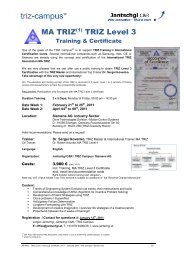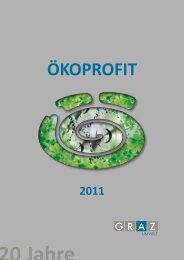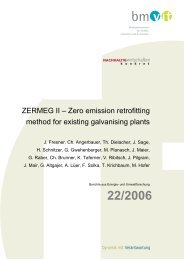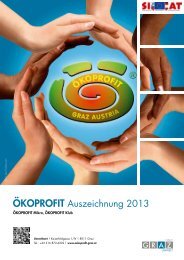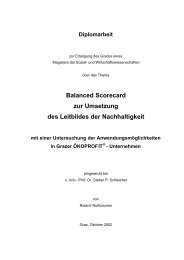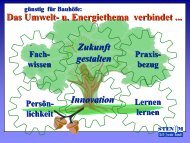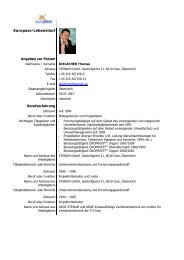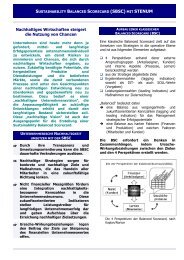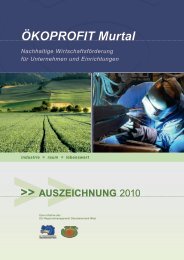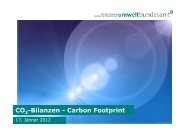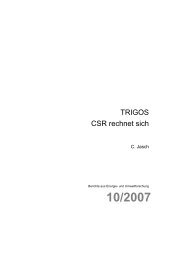Promoting Resource Efficiency in Small & Medium size ... - UNEP
Promoting Resource Efficiency in Small & Medium size ... - UNEP
Promoting Resource Efficiency in Small & Medium size ... - UNEP
Create successful ePaper yourself
Turn your PDF publications into a flip-book with our unique Google optimized e-Paper software.
Case Study: Anodisieranstalt A. Heuberger Ltd<br />
Anodisieranstalt A. Heuberger is an anodis<strong>in</strong>g company. It has 18<br />
employees <strong>in</strong> Graz, Austria. Annually, some 40.000 m 2 of alum<strong>in</strong>ium<br />
sheet metal, profile and small parts are treated <strong>in</strong> the plant. Anodis<strong>in</strong>g<br />
is a galvanic process <strong>in</strong> which the surface of the alum<strong>in</strong>ium is<br />
converted to alum<strong>in</strong>ium oxide, which protects the basic material<br />
aga<strong>in</strong>st corrosion and wear. By gr<strong>in</strong>d<strong>in</strong>g and polish<strong>in</strong>g, the surface can<br />
be prepared <strong>in</strong> different decorative qualities prior to anodis<strong>in</strong>g. The<br />
company is specialised <strong>in</strong> process<strong>in</strong>g orders with<strong>in</strong> a very short time.<br />
Heuberger has participated <strong>in</strong> the ECOPROFIT programme, a <strong>Resource</strong><br />
<strong>Efficiency</strong> programme run by the City of Graz s<strong>in</strong>ce 1996.<br />
Plan: Dur<strong>in</strong>g the plann<strong>in</strong>g phase an <strong>in</strong>ventory of materials, water<br />
and energy was made by the consultant, the general manager and the<br />
accountant. The prelim<strong>in</strong>ary assessment <strong>in</strong>dicated a focus on water<br />
was best because of the high consumption and cost as well as legal<br />
implications of wastewater generation. Wastewater ma<strong>in</strong>ly results from<br />
r<strong>in</strong>s<strong>in</strong>g parts after pickl<strong>in</strong>g and anodis<strong>in</strong>g.<br />
Do: Longer dripp<strong>in</strong>g times were <strong>in</strong>troduced to m<strong>in</strong>imize drag-outs.<br />
This reduces the amount of process solutions, which are carried from<br />
one process bath to the next on the surface of the parts, and therefore,<br />
decreases the need for r<strong>in</strong>s<strong>in</strong>g. The racks were changed for the same<br />
purpose. Spray r<strong>in</strong>s<strong>in</strong>g was <strong>in</strong>troduced to <strong>in</strong>crease the r<strong>in</strong>s<strong>in</strong>g effect.<br />
Check: A reduction of 30% of the production specific water<br />
consumption could be demonstrated after implementation of the<br />
measures. Therefore a cont<strong>in</strong>uation <strong>in</strong> 1997 was planned.<br />
Act: With a modified focus (this time on hazardous waste and<br />
<strong>in</strong>dustrial waste) the programme was repeated <strong>in</strong> 1997.<br />
Hazardous waste has been reduced to a m<strong>in</strong>imum: less than five litres<br />
of used compressor oil annually and it is sent to a waste <strong>in</strong>c<strong>in</strong>eration<br />
plant for the generation of district heat. Non hazardous waste is<br />
separated <strong>in</strong>to the fractions paper, metal, plastic, organic waste and<br />
<strong>in</strong>dustrial waste. Paper, metal and plastic are sent for recycl<strong>in</strong>g, organic<br />
waste to a compost facility.<br />
Packag<strong>in</strong>g materials are almost completely reused and the large<br />
quantity customers have developed returnable packag<strong>in</strong>g systems. The<br />
annual quantity of <strong>in</strong>dustrial waste amounts to as little as 1,500 kg.<br />
This represents a reduction of 50% <strong>in</strong> the amount of waste before the<br />
participation <strong>in</strong> the <strong>Resource</strong> <strong>Efficiency</strong> programme. The rema<strong>in</strong><strong>in</strong>g<br />
<strong>in</strong>dustrial waste ma<strong>in</strong>ly resulted from clean<strong>in</strong>g the shopfloor.<br />
Measures to reduce the consumption of natural gas <strong>in</strong>cluded the<br />
<strong>in</strong>troduction of covers for the baths when they are not <strong>in</strong> use and<br />
switch<strong>in</strong>g off the heat<strong>in</strong>g 30 m<strong>in</strong>utes before production stopped at<br />
night. This saved 5% of the natural gas consumption.<br />
In 1997 the company decided to cont<strong>in</strong>ue and to <strong>in</strong>troduce an<br />
environmental management system to systematize improvement.<br />
The <strong>in</strong>troduction of the management system started with an <strong>in</strong>itial<br />
review us<strong>in</strong>g the <strong>in</strong>formation collected dur<strong>in</strong>g the <strong>Resource</strong> <strong>Efficiency</strong><br />
project. The <strong>in</strong>formation collected <strong>in</strong>cluded:<br />
• Comprehensive <strong>in</strong>formation on material and energy <strong>in</strong>puts and<br />
outputs as well as options for improvement<br />
• Information on legal compliance<br />
• Information on the organisation of the company<br />
This drew attention to the overlap between health and safety, cleaner<br />
production and quality from the beg<strong>in</strong>n<strong>in</strong>g of the job. In this company,<br />
it resulted that the used materials’ effects on the environment were<br />
equally important as their effects on the employees handl<strong>in</strong>g them.<br />
Analys<strong>in</strong>g the potential failures of the process resulted <strong>in</strong> a list of<br />
environmental aspects as well as potential quality problems. The<br />
legal compliance audit covered the relevant legislation regard<strong>in</strong>g the<br />
environment, bus<strong>in</strong>ess law, and health and safety.<br />
From this review, a work<strong>in</strong>g programme was drafted that <strong>in</strong>cluded:<br />
• Development of a project to guarantee compliance with current<br />
Austrian waste water legislation<br />
• Evaluation and written documentation of the work<strong>in</strong>g conditions<br />
at all the workplaces to comply with this legal requirement<br />
• Increased tra<strong>in</strong><strong>in</strong>g activities to improve the understand<strong>in</strong>g of<br />
the process and the handl<strong>in</strong>g of chemicals to prevent accidents<br />
and to <strong>in</strong>crease the accuracy of process conditions<br />
• Def<strong>in</strong>ition of exact work<strong>in</strong>g procedures for anodis<strong>in</strong>g, analysis of<br />
process baths, ma<strong>in</strong>tenance. From a quality perspective, lack <strong>in</strong><br />
process control meant that approximately 5% of the parts had to<br />
be reworked, from an environmental po<strong>in</strong>t of view, this meant a<br />
5% <strong>in</strong>crease <strong>in</strong> use of chemicals, water, and energy<br />
• Investment <strong>in</strong> an air-cooled plant to cool the anodiz<strong>in</strong>g bath. This<br />
reduces the water consumption of the plant significantly and<br />
provides for better control of anodiz<strong>in</strong>g temperature, especially<br />
dur<strong>in</strong>g summer, thus improv<strong>in</strong>g the quality of the f<strong>in</strong>al product<br />
• Def<strong>in</strong>ition of responsibilities, corrective measures and an<br />
audit<strong>in</strong>g procedure<br />
• Documentation of the management system<br />
While evaluat<strong>in</strong>g the operators’ workplaces, the possibilities of<br />
accidents were analysed and documented. Measures for accident<br />
prevention were def<strong>in</strong>ed and implemented immediately.<br />
The first step to implement this programme was the <strong>in</strong>troduction<br />
of <strong>in</strong>dicators: the baths were analysed daily to optimise the use of<br />
chemicals. The quantities of chemicals used were recorded daily as<br />
were the quantities of water and methane. Changes <strong>in</strong> the specific<br />
consumptions were discussed <strong>in</strong> the meet<strong>in</strong>gs of the <strong>Resource</strong><br />
<strong>Efficiency</strong> team.<br />
The <strong>Resource</strong> <strong>Efficiency</strong> team was comprised of the manager, the<br />
production foreman, the employees <strong>in</strong> charge of ma<strong>in</strong>tenance and<br />
packag<strong>in</strong>g, and the secretary. The production foreman was also <strong>in</strong> charge<br />
of quality assurance and health and safety. So <strong>in</strong> fact the team covered<br />
Case Study<br />
30



